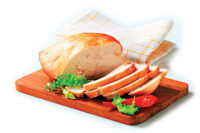Processing Technology
Whole-muscle products 'muscle' in on new trends
How do whole-muscle products stack up in the niche marketplace?




How do whole-muscle products fit in with the latest natural and grass-fed trends? Just fine, if processors can provide a consistent supply with no quality variations.
Currently, whole-muscle products are not being offered in new cuts. So, to generate more interest, some processors are launching local or grass-fed beef or free-range whole-muscle chicken options. While these products remain a small part of the market, they generate more than their share in social media buzz.
In Florida, for example, the Seminole Tribe has tied into the correlated trend of telling a story with a product by branding its natural and conventional whole-muscle meat products as Seminole Pride Beef, which are also non-hormone treated and antibiotic-free, grass- and corn-fed, says Dwain Johnson, Ph.D., professor, Department of Animal Sciences, University of Florida, Gainesville, Fla.
“Generally, the challenge with niche products is offering a consistent, year-round supply with no quality variations,” he says. “Processors may find they have enough product to get started but not enough for demand; and product variations can be wild.”
Commodity prices across proteins have certainly soared due to drought, decreased herds and porcine epidemic diarrhea virus (PEDV), he notes.
“As a result, casual-dining restaurants are pulling beef off their menus and substituting it with poultry items,” says Johnson. “Or, I’ve heard that the future is using cheaper cuts in comfort foods, like shredded beef in a wrap or bun, because of price.”
Another issue affecting commodities is that the weight of carcasses is up (by 12 pounds in 2013 in beef carcasses), causing larger sizes and weights of cuts, he says.
“So we need retail guys to adopt newer cutting styles like strips or fillets, as long as they aren’t cut too thin, in which case they can’t be cooked properly,” says Johnson. “Retailers who are willing to accommodate new fabrication styles will be ahead of the game.”
Indeed, the trend in branded products toward strip loins, pork loins, tenderloins, roasts, chops and poultry should certainly continue.
“Many of these are enhanced either mechanically to tenderize for beef or by injecting solutions containing ions, flavors and/or water-binding agents to enhance cooking robustness and eating quality for pork, poultry and lower-quality grade beef,” says Darl Swartz, Ph.D., Department of Biology, Delaware Valley College, based in Doylestown, Pa.
Marketing products without injections as “natural products” will also increase to fit this growing market segment, he says.
“Expect an increase in various ingredient diversity for cleaner labels and some emphasis on decreasing sodium,” says Swartz. “However, we can also expect a continued general slow decline in meat consumption, with an increase in the quality of the meat consumed — this is where this product group can shine.”
Protecting shelf life and food safety
Shelf life and food safety are always a concern for the industry. HACCP addresses these concerns with its guidelines, notes Swartz.
“Different bacteriostatic/bactericidal treatments, such as high-pressure treatment or chemicals such as lactates and acetates, address these concerns, and many have added product benefits in terms of tenderness and color stability,” he says.
The robustness of the meat once it reaches consumers’ kitchens is another concern.
“The variation in how the product is prepared at home can be substantial — end point temperature, cooking temperature, time and method — and has large impacts on final quality,” says Swartz.
This factor can be addressed by consumer education and training and by enhancing the product via mechanical tenderization and/or injection of solutions, he says.
“The main functional component(s) in the solution acts to retain moisture in the raw and final product,” says Swartz. “This in turn affords tenderness and juiciness in the cooked product, making it more robust in relation to cooking variables.”
Generally, there are two approaches to muscle tenderization: One is to leverage the ability of muscle proteins, primarily myosin, to bind and retain moisture, and the other is to add in another protein or polysaccharide that binds the moisture, he notes.
“The former use salts and/or varying levels of phosphates,” says Swartz. “Most of these increase the pH, and if tripolyphophate or pyrophosphate is included, further facilitate myosin functionality in moisture retention.”
Or, if processors add a protein or polysaccharide, they can use functionalized plant proteins such as soy protein derivatives and modified starches or algae-derived polysaccharides, such as carrageenan, he notes.
Maximizing quality
What considerations still need to be made when developing a whole-muscle product from an operations and quality standpoint? Processing and packaging to maximize shelf life and in-the-case appearance are still critical factors, says Swartz.
“In addition, processors can work with suppliers to tailor the solution formulations to their specific equipment, raw ingredients and targeted consumer segment,” he says.
Processors also need to work with vendors to develop optimal injection methods for their product and product flow, says Swartz.
“An additional concern with injection or mechanical tenderization relates to internal bacterial contamination of the product via injection,” he says. “This can be addressed through ingredient selection and/or solution treatment, as well as injector sanitation.”
Clear labels are in demand with consumers right now. So Swartz advises processors to check with the USDA and FDA regarding limits on different ingredients in the injected solution and labeling requirements.
“Also, the color of the cooked product may not be a good indicator of final temperature if pH is modified by enhancement, which should be addressed via the label, especially for beef,” says Swartz.
Pleasing consumers
Whole-muscle products are still viewed as the gold standard of the meat case by consumers, says Johnson, due to their high quality and special appeal.
“When consumers eat out, they want something special and memorable,” he says. “The challenge is getting these products to the plate in a reasonable price point today as prices go up.”
Swartz agrees that whole-muscle products are still popular for the sit-down type of meals associated with special occasions or weekend meals.
“They can fit into a ‘slow-food’ approach to the meal or meal preparation, and allow for the cook to add their special touch to the meal,” he says.
For consumers who want the slow-cooked taste but without the meal prep, further prepared or pre-cooked products are still popular, says Johnson.
“The challenge with whole-muscle cuts is that many consumers don’t want to put the time into preparing them,” he says. “A pre-cooked roast or brisket will be ready in 15 to 20 minutes, but the cost of convenience can be high.”
Consumers, however, still prefer them over their protein counterparts for a special meal of the week. “Yes, the smells, flavors and eating quality of a caringly prepared roast or steak make the meal,” says Swartz.
Looking for a reprint of this article?
From high-res PDFs to custom plaques, order your copy today!











